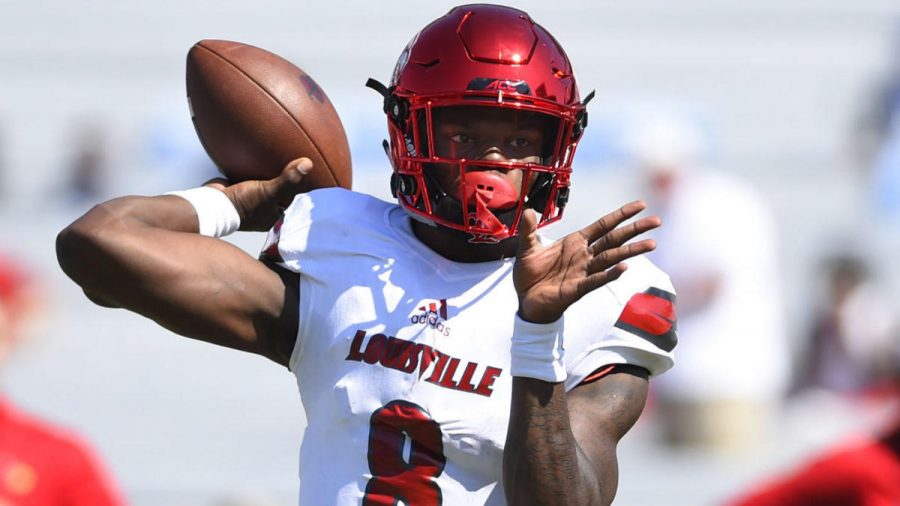Draft Profile: Lamar Jackson
April 9, 2018
The discussion surrounding one of the most exciting prospects ever highlights the NFL’s issues with race
It’s that time of year again.
Time to overanalyze your favorite college football players from yester-season, get hyped over players you’ve never of before, and tweet at the nineteen-year-old intern who runs your team’s social media accounts.
It’s also time to look at the guys who aren’t quite at the level of the top prospects. Many of them will try to switch positions, usually because their skill set might be better suited elsewhere. Tackles will be moved inside because they have short arms, cornerbacks will be moved to safety because they’re short, quarterbacks will try to move to various skill positions to better complement their athleticism.
The latter is most notable because of the degree of difficulty associated with it. For a quarterback to benefit from switching positions, his contributions at signal-caller must be unusually low and his upside elsewhere be intriguingly high. This is why a successful move for a quarterback is extremely rare.
Watch the Patriots on primetime, and it’s unlikely you’ll go the entire game without hearing how star receiver Julian Edelman was a quarterback in college. Same goes for Jerick McKinnon, who ran the triple-option in college as a quarterback — which I am fully aware is barely quarterback, but I still count it — and was just handed seven-and-a-half million dollars annually from the 49ers to be their starting running back. Even the Bills backup tight end Logan Thomas is notable for having made the switch after a couple of years in the league. Stories such as the Texans Braxton Miller, still a raw receiver, and Denard Robinson, who was a replacement-level starter at running back for the Jaguars, are much more common.
Of the players mentioned above, almost all are black. This is not a coincidence. (Though it is, of course, not exactly proportionate.) Though the NFL is seventy-percent black, a cursory glance at lists of NFL players who have switched positions reveals that the breakdown of players switching away from quarterback is disproportionately black. If we can assume that black players are not inherently more likely to be versatile or adaptable, then both this trend and a baseless application of it are based on something far from substantive.
The NFL has had a long, storied history of both racial issues and not being able to deal with said issues. Countless articles can be written — and have been written — about the various ways in which the both the league’s overt and institutional racism has marginalized black athletes over the years, but the most relevant issues here pertain to black athletes’ perceived ability to play quarterback. Despite originating as an integrated league, the NFL began segregating after a black star running back had the gall to act as disagreeable as white players. The NFL officially reintegrated in 1946, but black players were seen as unable to play positions more reliant on intelligence, such as quarterback and center. Though players like Fritz Pollard and George Taliaferro technically played the central position involving passing and running, it wasn’t until Warren Moon in 1984 that a black player became a long-term starter at the most important position in the modern sport. This paved the way for Randall Cunningham and Reggie Collier to enter the NFL, but the supply of black quarterbacks was still artificially low, since Power Five teams weren’t giving them opportunities — the first six black quarterbacks drafted in the first round were from Tennessee State, Grambling State, Houston, Syracuse, Oregon (prior to recent success), and Central Florida. And despite having Moon in the Hall of Fame, having Doug Williams win Super Bowl MVP, having Steve McNair and Cam Newton win league MVP, the NFL does not look like a demonstrably equitable and integrated league — as its eight primary starting quarterbacks from the 2017 season can attest. (Eight primary starters = 25% of them, in a league where, again, 70% of players are black. This. Is. Not. A. Coincidence.) One of them was even benched for a white guy whose talent was unknown but probably bad — while his team was in the middle of a playoff race.
Lest you think the NFL only racially scrutinizes quarterbacks, the center position, regarded as the second-most cerebral on the offense, was another position from which black players were often made to switch. Though the NFL reached a high watermark of black centers in 1998, the number of black centers is down, as low as nine percent of all centers in 2010. (In, again, a league that is 70% black.) There also happen to be eight black head coaches in the NFL, even with the Rooney Rule.
Countless Power 5 schools are starting black quarterbacks and three of the past eight Heisman trophy winners have been black quarterbacks (plus a Hawaiian). So why are so few NFL starters black?
It could certainly be for a lack of trying. Draft magazines from 2011 had Tyrod Taylor listed at running back and receiver, Colin Kaepernick listed at tight end, and Heisman Trophy and National Championship winner Cam Newton listed at tight end and defensive end. Defensive end! A position whose play is almost impossibly alien to that of quarterback. Cam Newton was the consensus first overall pick. To even suggest he play anywhere other than quarterback was patently absurd. T-Mobile (as Tyrod Taylor is often referred to) was good enough to be the eleventh quarterback drafted in 2011. When there were discussions in the draft industry about him switching positions, he responded, “I’m a quarterback.”
If that sounds a bit familiar, it’s because Lamar Jackson said nearly the same thing at this year’s combine. “I’m not going to be a wide receiver at all. I’m a quarterback,” he responded, when asked about reports of him being tried at receiver. He’s been a quarterback since high school, even having transferred schools early on to clear a path to starting. And his mother has always been keenly aware of the prejudice against black quarterbacks, making sure that there’s never been an opportunity for Jackson to be seen as anything else.
The staunchest defender of NFL institutions, if such a person were to exist, would have a hard time defending the idea of Jackson switching positions. But what makes the talk of Jackson — who, for a player of his celebrity, is in dire need of a nickname — moving to receiver most infuriating is the fact that several of the most notable “draft experts” have a guy by the name of Josh Allen in their top three quarterbacks. If you’ve never heard of him, Josh Allen is a very tall white guy who sometimes tried to play quarterback for Wyoming over the past few years. When he wasn’t trying to play quarterback, he specialized in randomly running around a lot and overthrowing open receivers. What he does consistently well is… up for debate. But he is very tall, and very white, and thus has a couple of skills that at least one NFL team highly covets. And because of that, there have been no discussions about him switching positions.
Congratulations if you’ve managed to make it this far through the article! Now for the actual prospect breakdown: it’s fairly simple. Jackson, were he white, would be in the discussion for the first overall pick. He can do just about everything you’d want out of a quarterback and more. He’s got great arm strength. He’s accurate to all parts of the field, he’s capable of easily escaping pressure from all areas and delivering accurate throws both under pressure and on the run. He responds fairly well to pressure, too, knowing when to slide up and when to roll out of the passing pocket. He’s more than capable of going through full progressions — Bobby Petrino’s offense is likely the most “pro-style” offense in the NCAA — and manipulating defenders out of position. He throws with touch, timing, and anticipation. He protects the ball fairly well. And he does all of these things consistently, which is perhaps the most important quality in any prospect. But beyond that, he’s the first quarterback since Michael Vick who defenses might not be able to catch. He didn’t run the 40-yard dash at the combine, but was constantly outrunning entire defenses at Louisville, and, besides, the 40 is irrelevant to game speed, anyway.
As Cian Fahey put it:
“In a league where Johnny Manziel goes in the first round, Lamar Jackson can’t play wide receiver. In a league where Zach Mettenberger goes in the sixth round with a torn ACL and goes on to sign with three teams, Lamar Jackson can’t play wide receiver. In a league where Bryce Petty goes in the fourth round, Sean Mannion goes in the third round, Cody Kessler goes in the third round, Kevin Hogan goes in the fifth round, Davis Webb goes in the third round and Christian Hackenberg goes in the second round, Lamar. Jackson. Can’t. Play. Wide. Receiver.”
Jackson’s comp, though it may seem lazy, is Michael Vick. The combination of elite speed and arm strength is unlike any other player’s in history. He probably won’t be as magical of a scrambler as Vick was, but he enters the league more refined, particularly in his ability to function within structure.
He’s my top quarterback prospect. And anyone who says he’s anything but a quarterback is abetting almost a century’s worth of racism.











